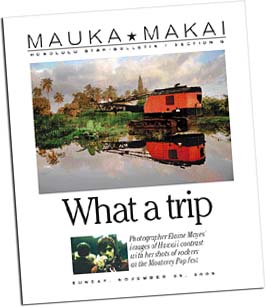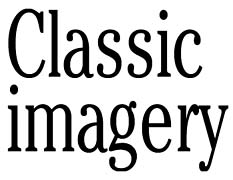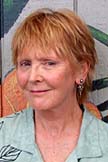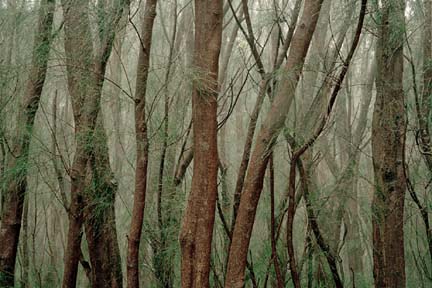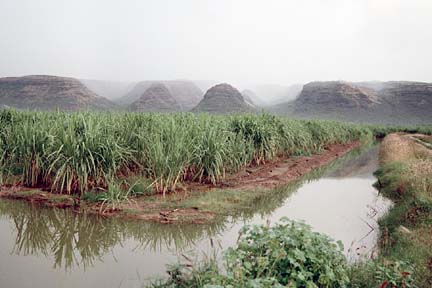
[ MAUKA MAKAI ]
COURTESY OF THE CONTEMPORARY MUSEUM
"Kumu Hula Iwalani Kalima and Keiki Dancers Hawaii 1992" is part of Elaine Mayes' exhibit at The Contemporary Museum.
From Haight-Ashbury
to Hawaii, photographer
Elaine Mayes has captured
a world of faces
What a long, strange trip it's been for Elaine Mayes, whose life as a photographer and educator has come full circle.
She went from photographing the Monterey International Pop Festival in 1967 to teaching visual art, rather than making it. Now she's back to her first love and back behind the lens, and that has meant giving up the safety net of academia.
It looks like she's on the right track, though. For starters, she has an exhibition of Hawaiian nature and local cultural photos on view at the Contemporary Museum at the First Hawaiian Center downtown. She's looking for a publisher for those photographic studies.
COURTESY OF
ELAINE MAYES
Photographer
"Hawai'i -- Its Land and Culture": A photo exhibit at The Contemporary Museum at First Hawaiian Center, 999 Bishop St., through Jan. 6. Hours are 8:30 a.m. to 4 p.m. Mondays through Thursdays, and to 6 p.m. Fridays. Closed on weekends and banking holidays. Free.
Elaine Mayes"It Happened in Monterey: Modern Rock's Defining Moment": A softcover photo book of the Monterey International Pop Festival in Monterey, Calif., June 16 to 18, 1967, published by Britannia Press, $29.95.
She was also in town recently, doing some publicity work for her first book of "classic photographs" of the Monterey International Pop Festival. The rock fest was a one-time event that took place in 1967 when hippie culture was in full flower. The event already has been well documented on film by D.A. Pennebaker and by other photographers, including Jim Marshall, who took the famous shot of Jimi Hendrix on his knees, coaxing out wailing feedback from his burning guitar.
But if it wasn't for Mayes stumbling upon her stash of festival photos in her New York loft 30 years after the festival, "It Happened in Monterey" would not have become a reality.
"I pulled together all the contributing comments from people like Grace Slick, Sam Andrew, John Phillips and Bill Graham," said Mayes, "and made the image choices and how they were sequenced in the book."
The festival's original poster artist, Tom Wilkes, designed the book's title page, a variation of that poster.
COURTESY OF BRITANNIA PRESS
Elaine Mayes' photographs from the 1967 Monterey International Pop Festival are collected in her book, "It Happened in Monterey: Modern Rock's Defining Moment." Above, Jimi Hendrix visiting a Monterey flower shop with a friend.
In 1967, Mayes was 28 and living in the Haight-Ashbury district of San Francisco when she was sent to the Monterey festival on assignment for the teen magazine Hullaballoo. She was familiar with most of the artists because of their earlier appearances in the Bay area. She had moved to the neighborhood from Marin County and lived for two years in a hippie household.
"I was initially there as a photojournalist, doing work for a free clinic," Mayes said. "And during the actual festival, there were no easy lines of definition between the artists and the audience. The musicians moved freely on the festival grounds and amongst the audience."
The pop festival was a groundbreaking event. "First, it was organized by musicians -- John Phillips (leader of the Mamas and the Papas) basically ran it." For three days in mid-June of 1967, musicians of different backgrounds gathered, most making their career-defining debuts to an influential California crowd.
"Janis Joplin made her name there," Mayes said, "as well as Jimi Hendrix and the Who. The Electric Flag, who pretty much invented the sound of rock and blues, was there. And the great Otis Redding, who brought his electrifying Southern R&B to the rock crowd."
Mayes said about 5,000 tickets were sold for the benefit concert, but as many as 100,000 to 170,000 people attended the multiday event.
(Mayes learned during her visit here that local promoter Tom Moffatt arranged to have orchids flown in from Hawaii and placed in the festival seats before Indian sitar great Ravi Shankar hit the stage.)
COURTESY OF BRITANNIA PRESS
Ravi Shankar ("He played 3-1/2 hours, and during that time you could've heard a pin drop," Mayes says).
THE PHOTOS collected in the book, interspersed with brief comments from participants, perfectly encapsulate that unique place in time.
"During the festival, I tried to get at least one picture of each musician performing. I was using a long lens, so that's why there are not many wide angle shots of the stage and the performers," she said.
Mayes, who splits her time with her husband between their New York and Oregon homes, is still basically a shy person, her photography drawing her out into the world.
She discovered photography when she went to the Art Institute in San Francisco. "It was a defining realization. I thought of myself as a watcher, so it was natural for my personality. I loved learning and exploring, and it was easier with a camera. I've certainly had a richer life because of it. I got to go to places I wouldn't ordinarily go."
Early in her career, while "working for graphic designers and medical journals," Mayes also did some photojournalism work for Sports Illustrated and Time magazines. "My heroes were W. Eugene Smith and Dorothea Lange -- photographers who were able to get that decisive moment on film -- and I wanted my pictures to be able to capture that specific idea in time."
COURTESY OF BRITANNIA PRESS
Otis Redding and Keith Moon, of the Who. "When compared to the other acts in the festival, the Who's stage act came off as a gross extravagance, what with the destruction of their instruments at the end -- they turned off some people with that."
After the Monterey festival and the end of 1968, a synchronistic event led to a career switch.
She had sold some prints from a Saturday Evening Post assignment on Chicago's Blackstone Rangers gang to the New York's Museum of Modern Art. "I later wrote the curator at the museum, saying that I didn't want to do commercial photography anymore and I was thinking about what else I could do."
When Mayes called the curator to follow up on her letter, he told her the University of Minnesota was looking for a photography teacher.
Mayes accepted the teaching post and became one of the first female college instructors in photography in the country. In 1970 she went to the then-newly founded Hampshire College in Amherst, Mass., "the first liberal arts college that had no planned curriculum and didn't use grades," she said. One of her students there was future PBS documentary filmmaker Ken Burns.
After 10 years at Hampshire College, Mayes held brief teaching positions at Bard College at Columbia University and the Pratt Institute School of Art & Design in New York, before her last stop at the Tisch School of the Arts at New York University, where she taught from 1984 to 2001.
"During all that time," she said, "I always did my work, although I was pretty invisible."
COURTESY OF THE CONTEMPORARY MUSEUM
Elaine Mayes' images of nature are another component of her exhibit. "Ironwoods in the Rain, Molokai 1992," above...
HER VISIBILITY stepped up a bit when, after doing photography workshops in Maui for NYU starting in 1989, she received a Guggenheim Fellowship grant to work in Hawaii.
"I've always loved the landscapes and culture of Hawaii, so in 1992 I would spend a month's time on each island. I was lucky in the sense that most local photographers didn't have this kind of an opportunity. It almost felt like a graduate project."
Using a 6-by-9 Fuji camera with eight exposures to a film roll, her large, inspired photos printed on archival paper using the inkjet process range from family portraits and hula halau to a Lanai pineapple-harvesting crew and a Ching Ming ceremony gathering in Manoa.
Mayes has continued to visit the islands regularly, and her Hawaii photos allow the viewer to gaze at familiar sights, seen fresh through a quiet and watchful soul. The scenes she has captured can be as seemingly mundane as the parking lot of the Pau Hana Inn on Molokai or a Christmas display outside a Manoa home. But her work also displays the haunting imagery of ironwood tree trunks in the rain on Molokai or the small spark of a cane fire in Puunene, Maui, at dawn, set apart from the eerie red glow of other fires afar.
"Both the festival and the Hawaii photos are documentary efforts," she said. "One was a commercial job, and the other supported by a grant and my interest. Both are attempts to describe a situation.
"It's all about seeing, being aware of what's going and working from an un-pre-planned perspective," she said. "It's simply looking outside and finding things."
COURTESY OF THE CONTEMPORARY MUSEUM
...and "Kekaha Cane Field, Kaua'i, 1989" are archival inkjet prints.
Click for online
calendars and events.
